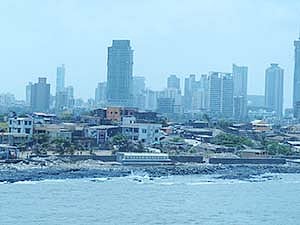Mumbai has over 16,000 tenanted and cessed buildings built before 1940. These dilapidated structures house thousands of families. Every year a few buildings collapse, trapping and killing people. But, residents continue to live under the propped up death traps, says NIDHI JAMWAL.

“Till the time a big bomb blast does not tear apart the entire C-ward, no politician or municipal officer will bother to look this way and redevelop the derelict buildings,” lashed out an angry A Karmakar on being prodded about the state of old buildings in his locality. Karmakar is a medical doctor, who owns a private clinic, Ashapura Clinic, in Chira Bazar area of Mumbai. He lives in a rundown building, whose one portion collapsed couple of years ago. To approach his residential tenement on the first floor of the building, he has put up a makeshift staircase, propped up to avoid another collapse.
Not very far from Karmakar’s clinic, is the Mauji Jairam Chawl in Bhuleshwar area of C-ward. This triple-storey chawl, with a total of 54 tenements, is over 125 years old. All the tenements are occupied by tenants who are living there for several decades. Garachs is one such family of four-members living in 180 square feet dwelling, comprising a room and an attached kitchen. There are common toilets, four on each floor of the building, shared by the tenants.
“This is a very old building and some portions are falling apart, but we get more worried about shifting out than living under its roof,” said Jayesh Garach, whose family is living in the chawl for the last 63 years. Jayesh’s father, Kishanbhai Garach, came to Mumbai from Gujarat over six decades ago. Kishanbhai runs a furniture shop at Tardeo, whereas Jayesh works at the local diamond market. For their 180 sq ft tenement, Garachs pay a rent of Rs 450 for three months.
Fifteen years ago, when the chawl started to fall apart, Maharashtra Housing and Area Development Authority (MHADA) carried out some repair work. But, nothing after that. “Every year, before the onset of monsoon, MHADA conducts survey of old buildings. However, no one has come to our chawl for such an inspection,” said Vaishali, Jayesh’s wife and mother of five-years-old Tanish.
In 2001, Garachs decided to move to a ‘new’ building in ‘safer’ locality and shifted to the suburb in Kandivali.
“As compared to the present 180 sq ft tenement, the Kandivali house was a spacious 2 BHK, over 800 sq ft in area. But, within one year, we moved back to the chawl in Bhuleshwar. We could not adjust there. Daily commute in local train was too tiresome. For us, Bhuleshwar is home,” said Jayesh.
After waiting for decades and realising the government is not interested in protecting lives of the residents, Garachs and other tenants of Mauji Jairam Chawl [chawl belongs to a trust] recently struck a redevelopment deal with Shri Hari Builders. As per the plan, the private builder is going to tear down the chawl and erect two 22-storey towers. Post redevelopment, all the 54 tenant families will get a 385 sq ft flat each.
“The builder will take three years to construct the towers and has offered a monthly rent of Rs 15,000 per family for those three years. As soon as the confusion over the property tax is cleared, the project will get underway,” added Jayesh. However, residents do not know what will happen if the builder fails to deliver in the specified three years period. There is no bank guarantee attached with the redevelopment project.
Nathu Lal Chaurasia has a word of caution for all tenants like Garachs. A co-ordinator at local NGO, Remaking of Mumbai Federation (RoMF), Chaurasia used to live with his wife and four children as a tenant in a 200 sq ft tenement in Moolchand Mansion building (Old Hanuman Lane, C-ward). It was over a 100 years old building owned by nine Bori siblings. In 2006, when the building was vacated for repairs, Moolchand Mansion housed 85 tenants. All the tenants allege they were cheated.
“In 2006, MHADA served a notice that the building was dangerous and should be vacated. Since MHADA does shoddy work, tenants decided to get the building repaired on their own, along with the owners’ help. All the tenants moved out of the building in 2006 thinking once the repair work is done, they would return back. However, the owners decided to construct new tower in place of the old building. In the process, a fight broke out between the nine owners and the matter is still pending before the court,” narrated Chaurasia. He claims that in spite of the known risks to life, tenants continue to live in dangerous buildings, as they cannot afford the current market rate of monthly rent, which is about Rs 15,000 for a 200 sq ft room in C-ward.
According to Viren Kapadia, property cell coordinator at RoMF, redevelopment of tenanted and cessed buildings is a highly complex issue. At the heart of the problem is the Bombay Rent Control Act, which provides that rent in excess of the standard rent is illegal except where an agreement entered into before September 1, 1940 provides for periodic increases.
“Rents in these old buildings are frozen since 1940s. Whereas buildings have grown old and dilapidated, landlords do not undertake maintenance because of the low rents. Tenants also do not have financial resources to repair the buildings. To top it all, government is least concerned about the well-being of residents of such derelict buildings,” said Kapadia. According to him, MHADA lacks both financial and human power to repair/redevelop all the old buildings in Mumbai.
The C-ward alone has 4,500-5,000 cessed and non-cessed old buildings housing 1.5 lakh people. Many of these buildings are in a state of imminent collapse. Some old buildings are being redeveloped either individually or as a cluster under the Development Control Regulation (DCR) 33(7) and DCR 33(9) respectively. For instance, the proposed redevelopment of Mauji Jairam Chawl is as per DCR 33(7). RoMF has prepared a master plan for redevelopment of 30 acres of Chira Bazar under DCR 33(9) for cluster redevelopment scheme. This plan is yet to be approved by the state government. And the time is running out.
While the government looks the other way, over 2.5 million Mumbaikars continues to live in 30,000 dilapidated buildings. It is what they call home. A home that may just also be their graveyard.





